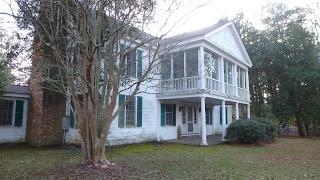After doing some trail scouting in the Walker Creek area of the Uwharrie National Forest, I decided to try to walk the length of the creek in the National Forest. Beginning at one end, I walked along an area which looked as if it had been impounded once. Suddenly, the creek dropped several feet in a short area, as seen above. I watched an otter slide down the cascade for a moment. When it was out of view, I turned around. There facing me, not 40 feet away, was a waterwall. I understand these are referred to as detention dams, outside Randolph County. This one was only on one side of the creek since the topography on the opposite side was steep. The purpose of the waterwall is to slow and redirect floods. Once these lands were fields and pastures and the rain runoff was much greater. I've been told they protect something downcreek from getting flooded.
This is a top view of the waterwall. Note the upcreek side is tapered. Both of the waterwalls I've seen on Walker Creek, had wide flat areas upcreek from them and narrow gorges downcreek.
I looked around the area to see if I could see anything else of interest. There were some pits and an old road but nothing else. Not too far from here is an almost fully intact chimney as well as a well defined old road which fords the creek at a low spot.
Walking upcreek from here, I switched back and forth from side to side looking for anything of interest.
This spot in the creek has a huge pile of rocks in the bed, forcing the water to one side.
As the banks began to steepen on both sides and the laurel thickened, I had to climb up out of the gorge and walk in open forest on creek right. It is here, I located these outcrops of rhyolite which appear to have been worked, possibly by Native Americans.
Crossing over to river left, I came into an area recently occupied by beavers. They had gnawed this tree down and then gnawed shorter pieces. I looked up and down the creek for signs of a lodge but saw none.
Some large rocks near the creek caught my attention. I followed them through the laurel to the creek. The rocks continued in the beyond the creek. They created a small island in this area. I was so enamored with this spot, I spent the better part of an hour here sipping on hot tea and eating lunch.
From there, I followed the mostly docile creek to the big waterwall. Knowing this is an archaeological site the Forest Service wants to protect, I wanted to find a trail route which would bypass this structure. A side creek enters Walkers Creek here. I followed it up and along a potential new route. I kept running into rock outcrops which appear to have been chipped away. For that reason and the fact I was so close to private property, prompted me to decide this was not a viable route. I'll be back again soon looking for that route.
























































